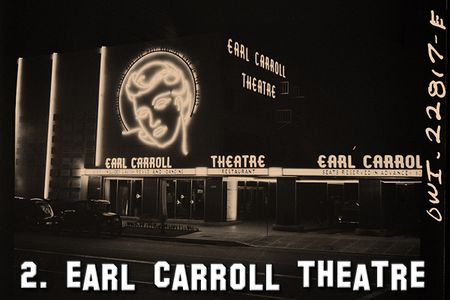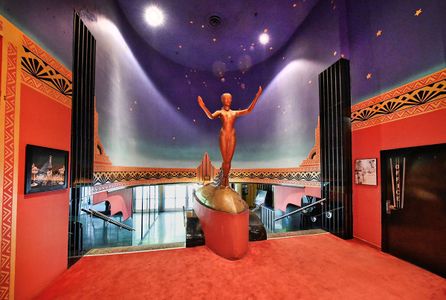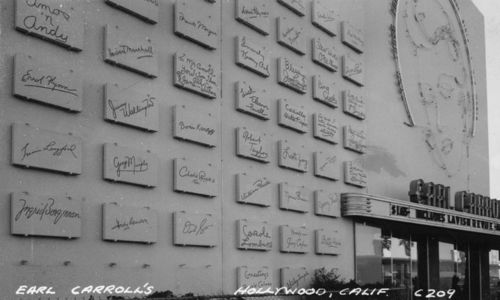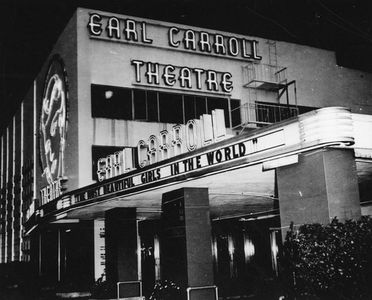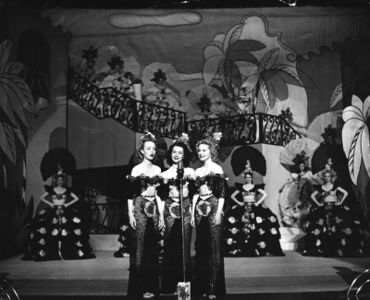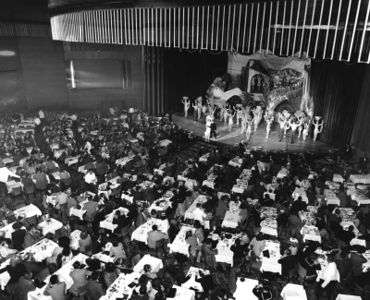Nickelodean Theater
Nickelodeon on Sunset (also called "Nick on Sunset"), built by showman Earl Carroll in 1938 as the Earl Carroll Theatre, was a stage facility located at 6230 Sunset Boulevard in Hollywood, California. It housed the West Coast production of live-action original series produced for the Nickelodeon cable channel from 1997 until 2017.
The theater will be preserved as part of a new development currently under construction, but a new operator has not yet been named.
Pre-Nickelodeon history
The Earl Carroll Theatre opened on December 26, 1938, with a lavish revue, Broadway to Hollywood, which featured sixty showgirls ascending 100 treads of stairs to a height of 135 feet. Many Hollywood celebrities were in attendance including Marlene Dietrich, Dolores del Rio, the J. L. Warners, Richard Barthelmess, Sally Eilers, Edgar Bergen, Claudette Colbert, Constance Bennett, Errol Flynn, Lili Damita, William Gargan, Jackie Coogan, Betty Grable, Mary Livingstone, Phil Harris, Conrad Nagel, Mary Brian, Darryl Zanuck, David O. Selznick, and Norman Krasna. The $1,000 membership fee guaranteed a lifetime cover charge and a reserved seat.
The building was designed in the Moderne style by architect Gordon Kaufmann. The interior design is attributed to both Count Alexis de Sakhnoffsky and Frank Don Riha (1899—1957). As he had done at his New York theater, Carroll emblazoned over the entrance the words "Through these portals pass the most beautiful girls in the world". The theater-restaurant accommodated 1,200 diners and offered shows on a massive stage with a 60-foot (18 m) wide double revolving turntable and staircase and swings that could be lowered from the ceiling. The building's façade was adorned by what at the time was one of Hollywood's most famous landmarks: a 20-foot-high (6.1 m) neon head portrait of entertainer Beryl Wallace, one of Earl Carroll's "most beautiful girls in the world", who became his devoted companion. The sign survived several changes of ownership and venue name but was completely removed during major decorative overhauling in 1968. A re-creation made from photos is today on display at Universal CityWalk, at Universal City, as part of the collection of historic neon signs from the Museum of Neon Art. Another prominent exterior feature was the "Wall of Fame", on which were mounted more than a hundred individual concrete blocks autographed by Hollywood celebrities, including some of the biggest stars of the 1930s and 1940s.
Earl Carroll Theatre, Hollywood
 Main article: Earl Carroll
Main article: Earl Carroll
The Moderne-style interior of the Earl Caroll Theater was lavishly decorated with zeon (a variation of neon) tube lighting and artwork, some of which remains extant. In 1939, Life magazine described the new building: “exhibits an ultramodern, super-streamlined interior with a patent-leather ceiling, 10,000 colored zeon lights, a 15-ft. statue, an acre of burgundy carpet...” The centerpiece of the foyer was the Goddess of Light, a 15-foot-tall aluminum-covered plaster statue (extant) designed by Martin Deutsch. With hands lifted to the ceiling, the statute held a fifty-foot zeon tube that wound its way to the ceiling. The columns in the lobby bar (extant) were filled with zeon lamps and zeon stalactites hung from the ceiling in the cabaret. A large painting of Carroll painted by the artist Strandanees hung near the main entrance.
Later achieving various degrees of fame in films and on television, Jean Spangler, Mara Corday, Yvonne De Carlo, Phyllis Coates, Maila Nurmi, Gloria Pall, Tyra Vaughn, and Mamie Van Doren were some of the showgirls who performed there. The facility was a popular night spot for many of Hollywood's most glamorous stars and powerful film industry moguls such as Darryl Zanuck and Walter Wanger, who sat on the Earl Carroll Theatre's board of governors.
The theater was sold following the 1948 deaths of Earl Carroll and Beryl Wallace in the crash of United Airlines Flight 624. It continued to operate but by the early 1950s it was falling on hard times.
In 1953, Las Vegas showman Frank Sennes reopened the theater as a nightclub under the name Moulin Rouge. The popular TV contest show Queen for a Day was broadcast from the Moulin Rouge during part of the show's 1956–1964 run. In late 1965 it became the Hullabaloo, a minors-welcome rock and roll club, capitalizing on the popularity of the television variety show Hullabaloo. The venue was also used for the 1966 concert film The Big TNT Show. For several months in 1968 it was the Kaleidoscope and featured many top West Coast rock acts, with an emphasis on local bands such as The Doors.
Later in 1968, the venue was redecorated in the psychedelic art style, renamed the Aquarius Theater, and rededicated as the home of a long-running Los Angeles production of the Broadway musical Hair. It was still sometimes used for rock concerts on Mondays, when the Hair company had its day off, and as a result the Aquarius is famous as the place where The Doors performed on July 21 & 22, 1969, making live recordings that were later issued commercially.
In 1977 it was briefly known as the Longhorn Theatre and has also been called the Sunset Boulevard Theatre.
In 1983, the Pick-Vanoff Company purchased the property and converted it into a state-of-the-art television theater that for nine years was the taping site of Star Search. The Pick-Vanoff Company also owned Sunset-Gower Studios, formerly the home of Columbia Pictures. For many years, it was used for the annual Jerry Lewis MDA Telethon. In the fall of 1993, the theater was the venue for Fox Network's The Chevy Chase Show under the name The Chevy Chase Theater. The talk show was a disaster and was cancelled after five weeks; the theater reverted to its previous name soon after.
Nickelodeon
In the mid-1990s, Nickelodeon decided to move production of some live-action series to the West Coast from Nickelodeon Studios in Orlando, Florida at Universal Studios. After scouting soundstages for a year, the network's headlining mover All That spent a year at Paramount Pictures before Nickelodeon obtained a lease for the 6238 Sunset Blvd facility, acquiring the sound stage and rebranding it Nickelodeon on Sunset by 1997. Due to limited studio space and the need to control plot spoilage for several programs, only a few series were taped at Nickelodeon on Sunset at a time. As a result, other live-action series produced for the network were filmed in other stage facilities with closed set policies throughout the Hollywood area. Some of the shows filmed there for Nickelodeon include the ten-season run of All That, The Amanda Show, Drake & Josh, and more recently iCarly and Victorious.
In 2004, the venue was sold to a private equity firm as part of a larger parcel of property. Nickelodeon moved out of the property in 2017. With the addition of a new low rise building being constructed next to the theatre, the venue will once again revert to the "Earl Carroll Theatre" name in 2020.
Post-Nickelodeon
The Los Angeles City Council designated the 1938 Earl Carroll Theatre Building as an Historic-Cultural Monument during its meeting on December 7, 2016. In September 2016, the City Council also approved Palo Alto-based developer Essex Portfolio's proposal to construct a new mixed-use building on the western portion of the site of the theater building. The project will retain the historic building and incorporate new construction on the adjacent surface parking lot. The new development will be seven stories in height and linked to the theater building via a pedestrian paseo. The project calls for 4,700 square feet of ground floor commercial space, as well as 200 residential units. Ground was broken on October 17, 2017;.
Chat rooms • What links here • Copyright info • Contact information • Category:Root
